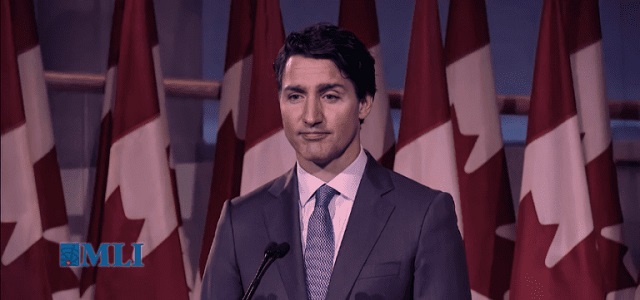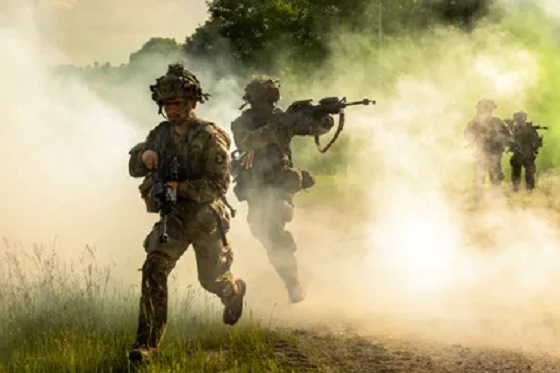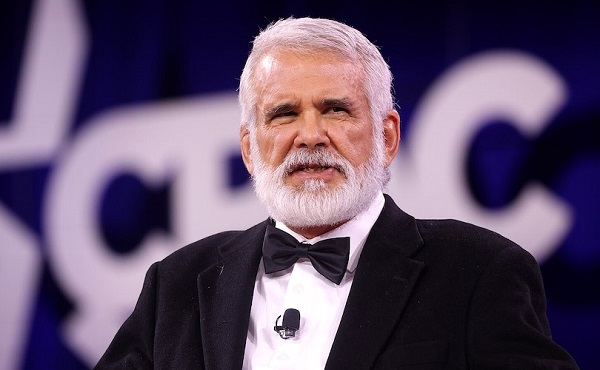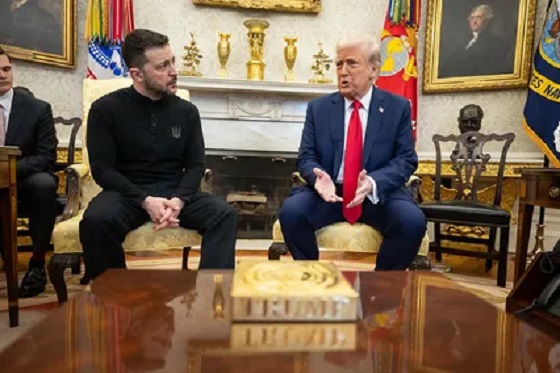armed forces
Federal government “not serious about defence,” warn Canadian military leaders

From the Macdonald Laurier Institute
J.L. Granatstein for Inside Policy
“The current prime minister of Canada is not serious about defence. Full stop. A large number of his Cabinet members are not serious about defence. Full stop.”
The Communist regime in China ramps up its aggression against Taiwan, while actively interfering in the political processes of Western democracies – including Canada. In Europe, Russia wages a brutal full-scale war against Ukraine, while sabre-rattling about nuclear strikes on our NATO allies. Meanwhile, Russian President Vladimir Putin’s Arctic ambitions threaten our sovereignty in the North.
With danger all around, one would think Canada’s federal government, led by Prime Minister Justin Trudeau, would be sounding the klaxon – rallying the country and steeling its citizens for looming conflicts with authoritarian regimes while bolstering our military for 21st-century warfare.
Alas, that seems to be far from the case, according to a pair of senior Canadian military leaders who warned recently about the federal government’s lack of commitment to and support of the military.
Over the course of four media reports that were published between May 12 and June 30, 2024, we heard the opinions of Lieutenant General (Ret’d) Andrew Leslie, and General Wayne Eyre, the Chief of Defence Staff who is retiring later this summer. Leslie, a former Liberal MP, was featured in the National Post on May 12 and again on June 30. As for Eyre, he appeared in an Ottawa Citizen article on June 20, and then in an end-of-term interview with the National Post on June 30 – just two days after the federal government announced the beginning of construction planning for the Royal Canadian Navy’s proposed fleet of fifteen destroyers.
Of these four articles, Leslie’s were by far the most important. The former Chief of Land Staff had retired from the Canadian Armed Forces to run for the federal Liberals in 2015. Elected to Parliament, he served four years – but then decided not to run for re-election. If Leslie was disillusioned, and he was, he kept silent in public until his National Post interviews. His remarks were extraordinarily blunt, but they seemingly failed to attract the public notice they deserved. Here in point form are some of his comments from his first interview:
- “The current prime minister of Canada is not serious about defence. Full stop. A large number of his Cabinet members are not serious about defence. Full stop.”
- “Our NATO allies are despairing. Our American friends are frustrated.”
- “[T]he Liberal government has no intention of meeting [the NATO standard of] two per cent (by 2030) and no intention of meeting 1.76 per cent [of GDP] (as promised in the April 2024 budget) because they rest confident in the smug knowledge that the Americans will always defend us.”
- “Since 2015, the Trudeau government has not spent, re-profiled, re-allocated, deferred, or lapsed $20 billion that was promised for defence. The impact of that is that ship fleets have not been replaced, aircraft are extraordinarily old, as are helicopters; the army is in a state of despair.”
These remarks from a former senior officer are, to my mind, devastating – much more so than those from Opposition politicians or academic experts. So too were the remarks Leslie offered on June 30:
- “According to the numbers I have 72% of the army’s vehicles and trailers are offline…. I think the big issue is, right now, the men and women in uniform don’t see any demonstrable proof that the federal government is actually seized of the issue of trying to get them the capabilities they need to better defend Canadians.”
- “The Liberal government sees defence spending as discretionary… They believe there’s a whole host of societal funding requirements, ranging from increases in healthcare, to day care, to children getting breakfast at school – and a bewildering array of boutique allocations of funds to cater to voter-sensitive initiatives. And defence comes after all of that.”
One area of special concern, Leslie maintained, was artillery shells, one of the many military items Ukraine needs in huge quantities. Canada, he stated, was falling down in producing them: “Canada has a tiny stockpile of 155-mm ammo…. One to two years prior to Russia’s latest invasion of Ukraine in 2022, a bunch of idiots decided to cancel the standing offer [with the two Canadian manufacturers of 155-mm artillery shells] because there was no business case for Canada to continue investing in the production of ammunition.”
Leslie ended the second interview by talking of those leaders he admired: “I had the privilege and honour to be in close proximity to three consecutive prime ministers who made the system work such that we bought tanks, artillery ammunition, small arms ammunition, helicopters, guns, armour-protective vehicles, new weapons systems, the list goes on. And those were Prime Minister [Jean] Chrétien, Prime Minister [Paul] Martin, and Prime Minister [Stephen] Harper.”
The general had been a member of the Trudeau government and had worked in drafting the Liberals’ defence platform in the 2015 election. But nothing had been done to implement it in a timely fashion. In Leslie’s list of prime ministers who took defence and national security seriously, Trudeau was notably absent.
The Ottawa Citizen article, by veteran defence reporter David Pugliese, was not a direct interview with General Eyre, but rather, a report on comments Eyre made behind closed doors in a speech to senior officers. Pugliese did not have a copy of Eyre’s speech but learned of it from an audience member.
According to Pugliese, Eyre, who only had a few weeks left as Chief of the Defence Staff, sounded almost optimistic about the Liberals’ 2024 budget that pledged $8 billion in new defence spending by 2030 and $73 billion more over twenty years.
Eyre reportedly told the officers, “Yeah, this policy was not as fast as we wanted it to be. And it did not give us everything we needed. But I will tell you it’s more than I expected, much more than I expected…. The prime minister told me that defence spending is only going in one direction and that is up.”
The general also reportedly spoke of creating a small team to work out an implementation plan for the new defence policy initiatives, and that he wanted some “quick hits… I see ammunition production as one of those quick hits that we absolutely have to get on with.”
In his interview with the National Post on June 20, Eyre was at times both pessimistic and positive in his assessment of the Canadian military: “[The world has entered a] pre-wartime security environment… If you’re in uniform, you learn to be pessimistic about the security situation because you’re trained for the worst case… Given the indicators and the trends that we see, I am pessimistic about the security situation…. Is this a 1938 moment? Is this a 1912 moment? The world has seen this before, with ebbs and flows, and we’re back in a multi-polar dangerous moment where the structures that have kept us generally at peace are fraying.”
If Eyre is right, Canada should be preparing for a war that is certain to affect Canada and its allies. But the Canadian procurement system for munitions and equipment is broken – a fact that Eyre freely acknowledges: “We are applying peacetime processes and peacetime mentalities to what could be considered a wartime or immediate pre-wartime security environment. So, what did we do in 1939? What did we do in 1914? We certainly didn’t take 10 or 15 or 20 years to get capabilities in place, because the war would be over by that point…. We have to deliver, and we have to deliver fast.”
The Chief of Defence Staff then spoke optimistically about Canada’s role in Latvia, where the Canadian Armed Forces leads the NATO brigade stationed there, and where the commitment is supposed to be increased in the next few years.
“We are very well respected in that part of the world,” Eyre said. “Do they want more of us? Yeah, absolutely, but for me it drives home that we produce a pretty good product…. [Canada] has and can do so much on the world stage. Compared to the majority of countries out there, we have got so much going for us.”
On June 28, 2024, Minister of National Defence Bill Blair and Angus Topshee, the Chief of the Naval Staff, announced the government’s plans to replace Canada’s Halifax-class frigates. Fifteen new destroyers would be constructed at the government’s estimate of $56 billion to $60 billion, Blair said. The Parliamentary Budget Officer earlier had estimated the construction cost at $84 billion with a “life-cycle” cost to operate and maintain the vessels at $306 billion. In reality, Blair’s announcement was not for the beginning of construction of the ships but only for a “test module.”
Some background is needed here. The Harper Conservative government in 2010 approved the National Shipbuilding Program, but it was not until 2018 that the Trudeau government, in power for three years, selected the as yet (and still) unproven British Type 26 ship as its choice. The vessels were to be constructed in Halifax at the Irving shipyards that first had to build the Arctic Offshore Patrol Ships, only completed this year (late and over-budget). Now in 2024, work at last can begin on the new destroyers.
The plan is that the first of the ships will be completed and ready for sea trials in 2033, 9 years from now and 23 years after the Harper government announced the shipbuilding program; presumably the first destroyer will not be deemed fully ready for service until at least 2034. (HMCS Halifax, the first of the frigates, went to sea in 1992, and by the time the first replacement is ready, Halifax will be 42 years old.)
But the planned completion of construction of all fifteen vessels will be glacial. Defence Minister Blair told Global TV on June 28 that the first nine ships would not be completed until 2040 and the remaining six not until 2050. In other words, it will take a quarter century for Irving to build fifteen ships – if it is able to maintain even that production schedule. The one certainty is that the ships will cost more to build – the rate of inflation for military construction is at least 6 percent higher than national inflation. The costs will be so high for these ships that it is all but certain that fewer than fifteen will ever be launched. Will any of the destroyers still be combat effective by 2050? That seems highly unlikely.
Remember what Eyre told the National Post: “We are applying peacetime processes and peacetime mentalities to what could be considered a wartime or immediate pre-wartime security environment…. We have to deliver, and we have to deliver fast.” And don’t forget Leslie’s damning comment: “The current prime minister of Canada is not serious about defence. Full stop. A large number of his cabinet members are not serious about defence. Full stop.”
At the July NATO summit in Washington, American leaders increased the heat on Trudeau to reach the 2-percent-of-GDP benchmark for military spending. “Welcomed @CanadianPM Trudeau to the U.S. Capitol today,” U.S. Senate Republican Leader Mitch McConnell wrote on X on July 9. “Shared values and close economic ties have always been the strength of the U.S.-Canada relationship. But it’s time for our northern ally to invest seriously in the hard power required to help preserve prosperity and security across NATO.”
The Trudeau government will be long gone by the time the first of the new destroyers puts to sea, and it will be completely forgotten by the time the last one sets sail. We must hope that no war intervenes in the next quarter-century because Canada certainly will not be ready – and not only with its navy. “Not serious about defence”– let’s hope we will not pay a high price for the neglect of this country’s most vital national interest.
J.L. Granatstein taught Canadian history, was Director and CEO of the Canadian War Museum, and writes on military and political history. A member of MLI’s Research Advisory Board, Granatstein’s most recent book is Canada’s Army: Waging War and Keeping the Peace. (3rd edition).
armed forces
Trump rebuilds the ranks: Army crushes 2025 recruitment goal early

 MxM News
MxM News
Quick Hit:
The Army has already exceeded its 2025 recruiting goal of 61,000 troops—four months ahead of schedule—as the Trump administration’s rollback of woke policies draws thousands back to military service.
Key Details:
-
The Army’s 2025 recruiting goal was 61,000—higher than last year’s 55,000—and has already been met with more than four months remaining in the fiscal year. Officials report a 56% increase in average daily enlistment rates over last year.
-
Army Secretary Daniel Driscoll thanked Trump and Hegseth, saying their “decisive leadership” and “putting soldiers first” contributed to the record-breaking numbers.
-
Hegseth has aggressively pushed to eliminate leftist cultural initiatives in the military, including moves to administratively separate transgender troops and rename a Navy ship previously dedicated to gay rights icon Harvey Milk.
Diving Deeper:
The U.S. Army has reached a major milestone ahead of schedule—signing up 61,000 new recruits in fiscal year 2025, effectively smashing its annual goal months before the September 30th deadline. The achievement marks a dramatic shift after years of underperformance and is being touted as a vindication of the Trump administration’s efforts to reorient the military away from progressive social engineering and back toward warfighting readiness.
In a Wall Street Journal op-ed Tuesday, Army Secretary Daniel Driscoll praised the recruiting corps, attributing their success to both boots-on-the-ground determination and high-level support. “I’m incredibly proud of our U.S. Army recruiters and drill sergeants,” he said. “Their colossal efforts and dedication to duty helped the U.S. Army accomplish our FY25 annual recruiting goal a full four months ahead of schedule.” Driscoll continued, “I want to thank the commander in chief, President Trump, and Secretary of Defense Hegseth for their decisive leadership and support.”
The Army’s target of 61,000 recruits was a notable jump from last year’s 55,000 goal. Officials say that as of this month, daily enlistment figures are tracking 56% higher than the previous year.
Driving the increase, many believe, is the sweeping overhaul of military culture underway under Defense Secretary Pete Hegseth. Hegseth has made no secret of his intent to steer the armed forces away from what he calls “woke and weak” policies. That includes the Pentagon’s past focus on gender identity politics, climate initiatives, and mandatory diversity training—priorities Hegseth sees as incompatible with combat readiness.
“We are leaving wokeness and weakness behind,” Hegseth declared during remarks last month at the Special Operations Forces Week convention in Tampa. “No more pronouns, no more climate change obsession, no more emergency vaccine mandates. No more dudes in dresses. We’re done with that s***.”
Hegseth emphasized a military rooted in “lethality, meritocracy, accountability, standards and readiness,” and added pointedly, “Our combat formations don’t need to look like Harvard University—they need to look like killers.”
In line with that shift, Hegseth also this week ordered the Navy to remove Harvey Milk’s name from a replenishment ship. The vessel had been named in honor of Milk, a gay rights activist and former Navy officer who was elected to the San Francisco Board of Supervisors in 1977 before being assassinated a year later.
The directive aligns with what Hegseth calls “warrior culture” and the broader mission to reflect Trump administration priorities across the military’s assets and institutions. The Pentagon has yet to confirm a new name for the USNS Harvey Milk, and a spokesperson said reviews are ongoing.
The Army is set to mark its 250th anniversary on June 14th—a symbolic moment, officials say, as it reclaims its footing and begins to rebuild the force from a position of strength.
armed forces
New Trump-Pentagon ad resets mission: end wokeness, win wars

Quick Hit:
The Pentagon released a dramatic new ad Sunday featuring President Trump and Defense Secretary Pete Hegseth, highlighting the end of woke policies in the military and a renewed focus on strength, discipline, and warfighting.
Key Details:
-
The ad, titled Peace through Strength, features intense training and combat scenes, underscored by speeches from Trump and Hegseth.
-
“No more distraction, no more electric tanks, no more gender confusion, no more climate change worship,” Hegseth proclaims, signaling a sharp pivot from recent Pentagon policies.
-
Trump promises that under his leadership, U.S. military success will be defined “not only by the battles we win, but also by the wars we end,” calling for peace built on American strength.
NEW U.S. MILITARY AD HITS HARD🇺🇸
"We are laser focused on our mission of warfighting… Our friends will respect us, our enemies will fear us, and the whole world will admire the unrivaled greatness of the United States Military" pic.twitter.com/jdm3MikswO
— The White House (@WhiteHouse) May 27, 2025
Diving Deeper:
The Pentagon launched a forceful new recruitment and branding campaign over Memorial Day weekend, spotlighting the military’s return to fundamentals under the leadership of Defense Secretary Pete Hegseth and President Donald Trump. The minute-long ad, titled Peace through Strength, premiered Sunday at the Coca-Cola 600 NASCAR event and was simultaneously posted to the Department of Defense’s social media accounts.
Using fast-paced training footage and dramatic music, the ad showcases troops in battlefield simulations and highlights a no-nonsense message from the Trump administration. Hegseth opens with a clear declaration: “No more distraction, no more electric tanks, no more gender confusion, no more climate change worship. We are laser-focused on our mission of warfighting.”
The video includes remarks from Trump affirming his vision for a military built on discipline and deterrence. “Through our power and might, we will lead the world to peace,” he says. “Our friends will respect us. Our enemies will fear us. And the whole world will admire the unrivaled greatness of the United States military.”
The ad was produced using previously recorded training footage, according to a Pentagon spokesperson who spoke to The New York Post.
Hegseth also makes a direct appeal to America’s youth, praising “incredible” young men and women “giving up the best years of their lives” to defend the country. He closes the ad with a quote that underscores the values behind the mission: “We don’t fight because we hate what’s in front of us. We fight because we love what’s behind us.”
The backdrop to the ad is a recruiting crisis that had plagued the military under Biden. In fiscal year 2022, the U.S. Army fell short by roughly 25% of its enlistment target. Similar gaps were recorded across other branches in 2023, with both the Navy and Air Force reporting thousands fewer recruits than needed.
Reversing that trend has been a key objective for Hegseth. He has made it clear that returning to a warrior culture—and scrapping the distractions of social experimentation—is central to solving the problem.
The ad’s release comes just days after the House passed the One Big Beautiful Bill Act, which adds $150 billion in new military funding. That package includes investments in shipbuilding, defense modernization, and Trump’s space-based Golden Dome missile defense initiative.
Together, the new ad and the legislation serve as a one-two punch from the Trump administration, signaling a full-spectrum push to rebuild, rearm, and reinspire the U.S. Armed Forces.
-

 International20 hours ago
International20 hours agoIsrael’s Decapitation Strike on Iran Reverberates Across Global Flashpoints
-

 Business2 days ago
Business2 days agoThe carbon tax’s last stand – and what comes after
-

 Business1 day ago
Business1 day agoTrump: ‘Changes are coming’ to aggressive immigration policy after business complaints
-

 illegal immigration1 day ago
illegal immigration1 day agoLA protests continue as judge pulls back CA National Guard ahead of ‘No Kings Day’
-

 Business2 days ago
Business2 days ago84% of Swiss hospitals and 60% of hospitalizations are in private facilities, and they face much lower wait times
-

 International2 days ago
International2 days agoPentagon agency to simulate lockdowns, mass vaccinations, public compliance messaging
-

 National2 days ago
National2 days agoCarney promotes MP instrumental in freezing Freedom Convoy donors’ bank accounts
-

 Health2 days ago
Health2 days agoRFK Jr. appoints Robert Malone, Martin Kulldorff, other COVID shot critics to overhauled CDC vaccine panel






